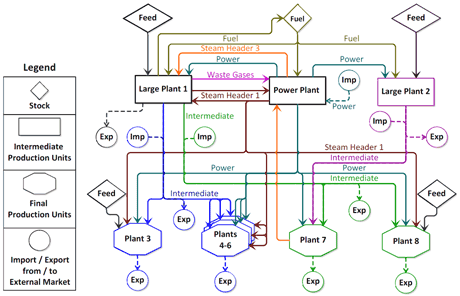by Radoslav Paulen and Sebastian Engell
We are developing new tools for the management of large physically-interconnected production and distribution systems.
The well-being of the citizens of Europe depends on the reliable and efficient functioning of large interconnected systems, such as electric power systems, air traffic control, railway systems, large industrial production plants, etc. Such large systems consist of many interacting components, such as generation plants, distribution systems, and large and small consumers. Those subsystems are usually managed locally and independently, according to different policies and priorities. The dynamic interaction between the locally managed components gives rise to complex behaviour and can lead to large‐scale disruptions, such as power black-outs. Large interconnected systems with autonomously acting sub-units, such as these, are called “systems of systems”.
DYMASOS addresses the issues associated with managing systems of systems, where the elements of the overall system are coupled by flows of physical quantities, such as electric power, steam or hot water, materials in a chemical plant, gas, potable water, etc. DYMASOS, initiated in October 2013, is a three-year research project funded by the European Commission under the 7th Framework Programme for Research & Technological Development in the “Information and Communication Technologies” theme.
DYMASOS focuses on the theoretical approaches for dynamic management of physically coupled systems of systems driven by and validated on real-world use cases and supported by eventual deployment of prototyped methodologies and toolsets. The DYMASOS consortium comprises academic partners, industrial partners, small and medium enterprises and a large provider of engineering and technological solutions.

Figure 1: A schematic representation of a physically-coupled system of systems using a chemical production site as a case study.
The project will develop new methods for the distributed management of large physically connected systems with local management and global coordination. The explored approaches involve:
- Modelling and control of large-scale systems analogously to the evolution of the behaviour of populations in biological systems,
- Market-like mechanisms to coordinate independent systems with local optimization functions,
- Coalition games in which agents that control the subsystems dynamically group to pursue common goals.
The developed approaches will be validated in large-scale simulations of case studies provided by the industrial partners or already involved supporters from the industry. From the validation, general conclusions will be drawn about the suitability of the proposed distributed management and control mechanisms for certain classes of systems of systems. This will provide guidelines for the design of evolving large physically coupled systems of systems with respect to the interplay of local autonomy and global management. These guidelines, developed in close collaboration with industrial partners, will influence the next generation of software and hardware development for optimal management of large interconnected systems.
The industry-driven case studies of real applications that are considered in the project include:
- The balancing and stabilizing of the electricity distribution grid of the city of Koprivnica that is a highly-automated complex system involving multiple electricity producers and consumers (households, charging stations of electrical vehicles, etc.).
- The dynamic management of charging of electric vehicles in the city of Malaga that involves the management of the network of electrical vehicles and power station with vehicle-to-grid charging capabilities.
- The energy management of a large chemical production site that seeks the right balance for an operation of the power plant (steam network) to satisfy the demands of the production subunits and to minimize the amount of imported energy resources.
- The cross‐plant process management in an integrated chemical production complex. This case study is concerned with managing a network of parallel reactors that share a flare system and limited cooling power.
For the usability of the results, it is essential that the engineering, implementation and long-term maintenance of such advanced solutions are taken into account. The project will develop prototypical tools that facilitate development, testing, deployment and maintenance of these solutions. A key element of these engineering tools is an open simulation platform that enables dynamic management and control methods to be tested with accurate models of the overall system and the connection to external models that are available in the application domains.
The expected technical outcomes of the project are:
- Innovation in distributed management methods for complex interconnected systems,
- Progress in methods for the rigorous analysis and validation of systems of systems,
- Improvements in the management of electric grids and of large production complexes,
- Tools for the engineering of management systems for systems of systems,
- Identification of technology gaps in advanced management and coordination methods.
The developed coordination methods will lead to improved system stability and lower resource consumption in industrial production, and in electric power generation and distribution. This will result in a reduction of the CO2 emissions, increased competitiveness of European industry and lower prices for consumers. DYMASOS is thus contributing to the goal of a greener and more competitive Europe.
Link: http://www.dymasos.eu
Please contact:
Sebastian Engell
Technische Universität Dortmund Germany
E-mail:











